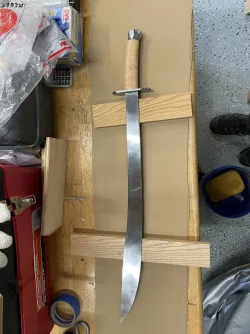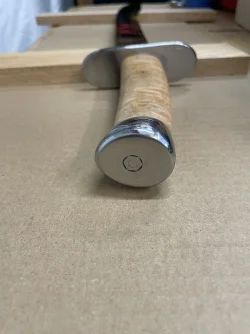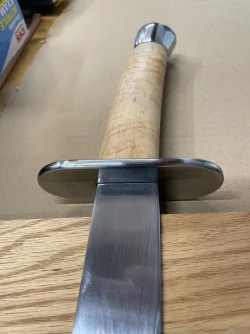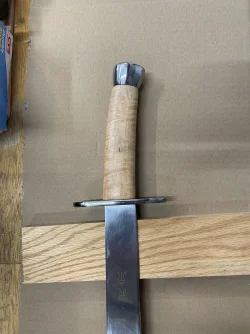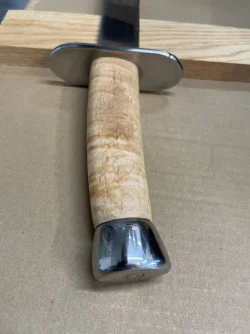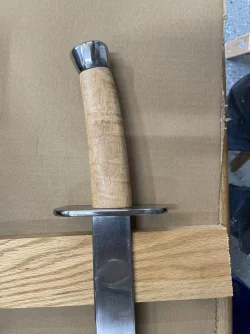Flying Crane
Sr. Grandmaster
Just where the balance point is depends on a lot of things, including personal preference. The overall weight of the sword, the length of the blade, how well it is distally tapered (thinning as it gets closer to the tip) as well as the profile tapering to a point, the size and weight of the pommel and guard, the length of the grip, etc. all contribute.My swords balance about 6 inches from the guard, so it naturally wants to tilt down when held. Before doing my work out, this sword was anything but lively, but now I can move it with some speed.. Now the problem is one of controlling the little speed that I can generate. Once it gets going the stopping part becomes tough on the wrist and I find myself naturally using my other hand to stop the swing of the sword.
I've had the sword for maybe 20 years so I'm comfortable with the tip being heavy especially now that I'm stronger. By the time I'm able to use 20l lbs with ease, these swords are going to feel like tooth picks.
In general, I prefer the balance point somewhere around 3-4 inches down the blade, from the guard. But again, that depends on the issues above and can vary from one of my swords to another. I know some who prefer the balance point right where the guard meets the blade. I find that kind of balance to make something of a "dead" sword, it doesn't want to move and it just doesn't feel right to me. Having a balance point a few inches down makes the blade more "alive" to me, makes it want to move.
As someone who has rebuilt a lot of swords and put new hilts on them (grip, guard, pommel), achieving a balance point right at the guard is only realistic on very light swords, the type that are meant for taiji forms competitions or Modern Wushu competitions, or at the best, something that would be barely serviceable as a personal defensive weapon against unarmored assailants, and would have no place on an actual battlefield. I have tried to achieve such a balance on heavier blades, including some that were somewhat over-heavy. What happens is that you end up putting so much weight on the pommel that it becomes something like a shot-put on the back of the sword. The whole piece is simply so heavy that it becomes unuseable.
I will say that a sword like a dao tends to demand a balance point a bit farther down the blade than a jian would typically have. This is because the dao is meant more for slashing and chopping, and a bit more forward weighting is more appropriate for those techniques. I have trained with heavy-weight dao that were difficult to use because of the weight. I actually chopped the blades down a bit, to reduce the overall weight and remove some of the wide flairing of the tip of the blade that is typical of the oxtail type dao that can make it more difficult to maneuver (I prefer the slimmer willow leaf dao myself).
but at any rate, I feel that personal preference should be given more leeway than some people are willing. I've spoken with some people who seem to feel that a sword should have the balance at X point, and there isn't much room to debate, in their opinion, because that is "proper".
Practice with the sword can help tremendously with the strength of the grip, forearm, arm and shoulders/upper back, and if done correctly will help you with your foundation techniques, even your empty-hand material. The sword is heavy enough that it does not let you cheat in your technique. If you try to swing it with just the arm and shoulder, you get tired quickly. If you drive the swing with the entire body, you can keep going without getting tired. The lesson is clear and you quickly begin to clean up all of your techniques once you begin working with realistically weighted weapons.
Finally, I practice with both sides of the body, right-handed and left-handed, with all of my weapons. I feel it helps the body develop evenly by doing that, and it is a good mental exercise to transfer the skills to your weak side. You will always be better and cleaner on your strong side. But you can develop real skill on your weak side as well if you work on it. And remember: if you and your band of survivors are caught by a herd of zombies and you are fighting your way out, what happens if your sword-hand gets bit? You've got about 30 seconds before the Zed virus works through your body and you will become one of them. You need to switch hands, chop off the bitten hand, and still fight your way out. If you have never tried to use your sword with your weak hand prior to that moment, you are good and screwed.

